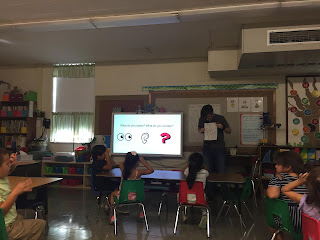Friday Reflections - 3 Acts of a Mathematical Lesson
 |
| Kayla teaching her class |
Kayla’s lesson certainly motivated me to uncover some of the basics of Three Acts.
Use a picture of video from everyday life or a picture from a book/textbook that piques mathematical interest Kayla used a video of her handing jelly beans to someone; enclosed is Kayla’s power point for her lesson.
Act 1 – Ask a question about the visual – In Kayla’s world of five year olds – the burning question is How many jelly beans did she give her friend? As you move into more challenging scenarios perhaps such questions as How many red jelly beans were in Kayla’s hand? or What if Kayla wants to share only half the jelly beans? Or What if Kayla’s friend likes only certain flavors of jelly beans? Or What if Kayla wants to share with her friend and save some for her little brother?
 |
| Students drawing their guess |
Act 2 – It’s the modeling process – What do you need to know to answer the question? How are you going to find the resources?
Act 3 – Did we arrive at a correct answer? Could there be more than one answer? Could we have eliminated some unnecessary information? In this Act – have students give a title to the lesson.
Lots of great stuff going on in this Three Acts approach to math. If you are a math teacher and are interesting in exploring more on this subject, you would benefit from listening to Ted talk by Dan Meyer. He gives some great examples of how to structure math tasks that will not only engage students but will foster deeper mathematical thinking.
Our future world is already requiring more complex mathematically thinking – Kayla, you are starting off our youngest on the right track mathematically. Thank you for inviting me to participate and for pushing my knowledge of math.
The Janet/Kayla team is a winning team!
Lots of great stuff going on in this Three Acts approach to math. If you are a math teacher and are interesting in exploring more on this subject, you would benefit from listening to Ted talk by Dan Meyer. He gives some great examples of how to structure math tasks that will not only engage students but will foster deeper mathematical thinking.
Our future world is already requiring more complex mathematically thinking – Kayla, you are starting off our youngest on the right track mathematically. Thank you for inviting me to participate and for pushing my knowledge of math.
The Janet/Kayla team is a winning team!
Comments
Post a Comment